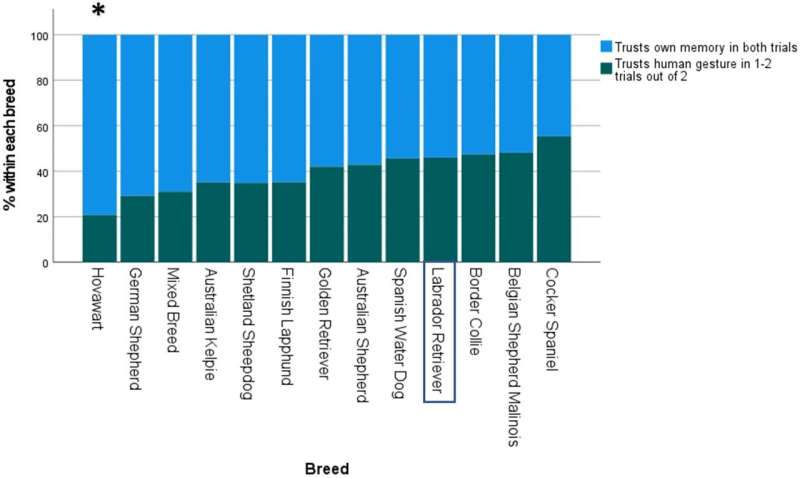January 10, 2023 report
This article has been reviewed according to Science X's editorial process and policies. Editors have highlighted the following attributes while ensuring the content's credibility:
fact-checked
peer-reviewed publication
trusted source
proofread
Using a standardized test battery to compare cognitive and behavioral traits in dog breeds (Update)

A team of researchers affiliated with multiple institutions in Finland has analyzed test data to investigate how breeds differed in different cognitive and behavioral traits. In their paper published in Scientific Reports, the group describes their analysis of the test results for more than 1,000 dogs representing 13 breeds.
The work by the team involved assessing participants in a commercial cognitive test battery (smartDOG), which had been developed by Katriina Tiira, one of the members on the research team. The dogs were tested between March 2016 and February 2022.
The battery involves measuring different cognitive traits, from spatial problem solving to logical reasoning, to impulse control and an ability to read human gestures and respond appropriately. Some of the tasks also involved memory and an ability to mimic a given behavior. One task involved noting the conditions under which a dog will ask its human trainer for help on an unsolvable problem.
The researchers limited their analyses to dogs between the ages of 1 and 8 years, since cognitive traits may not have fully developed in younger dogs and older dogs may experience cognitive decline. They also only included dog breeds with a minimum of 40 individuals tested per breed.
As a result, the team found significant differences between individual dog breeds for five of the seven cognitive tests included in the test battery, including social cognition, persistence, inhibitory control, and spatial problem-solving ability. Differences were also evident for activity level, greeting of an unfamiliar person, and exploration of a novel environment. In contrast, no breed differences were found for short-term memory or logical reasoning.
Inhibitory control and social cognition are likely important traits in the selection of dog breeds, for example in herding dogs. In this study, the border collie and Australian shepherd were among the highest-scoring breeds in the test for inhibitory control. In contrast, the Malinois and German shepherd were some of the lowest-scoring breeds as they are often used in working roles requiring high responsiveness, which is often associated with low inhibitory control and high impulsivity.
Human-directed behavior and socio-cognitive abilities may be highly valued in pet dogs expected to work closely with people, such as herding dogs and retrievers. In line with this, the kelpie, golden retriever, Australian shepherd, and border collie spent the largest proportion of their time on human-directed behavior, whereas the German shepherd and Malinois were completely independent during the unsolvable task.
In conclusion, many of the results seemed to reflect the breeds' original or current function, but several breed differences could not be easily explained by breed function alone. Behavioral variation within breed groups could be substantial. For example, the golden retriever differed significantly from the Labrador retriever in the unsolvable task and the gesture test, even though both belong to the retriever group.
The researchers purport that their findings therefore highlight the importance of investigating behavioral differences between individual breeds rather than only relying on breed group categorizations.
More information: Saara Junttila et al, Breed differences in social cognition, inhibitory control, and spatial problem-solving ability in the domestic dog (Canis familiaris), Scientific Reports (2022). DOI: 10.1038/s41598-022-26991-5
Journal information: Scientific Reports
© 2023 Science X Network





















